Renk Lekesi Fırça İşletkesi¶
Renk Lekesi Fırçası, renkleri bulaştırarak veya matlaştırarak karıştırmanıza olanak tanıyan bir fırça işletkesidir. Ressamlar için çok kullanışlıdır.
Seçenekler¶
Renk Lekesi Fırçasına Özel Seçenekler¶
Renk Oranı¶
Ön plan renginin ne kadarının leke karışımına ekleneceği. Leke Uzunluğu ve Leke Yarıçapı ile birlikte çalışır.
Bulaştırma Kipi’ndeki farklı matlıklar, leke uzunlukları ve aralıklara sahip çeşitli renk lekesi darbeleri. Hepsi %50 Renk Oranı iledir. Soldaki set eski algoritmayı, sağdaki set ise yeni algoritmayı gösterir. Alttaki iki darbe ise Color Dodge harmanlama kipini kullanıyor.¶
Added in version 5.0: Yeni leke algoritmasını kullan seçeneği, Renk Oranı’nın çalışma şeklini büyük ölçüde etkiler. Eski algoritmada, Renk Oranı hem leke uzunluğundan hem de matlıktan etkilenirken, yeni algoritmada Renk Oranı yalnızca Matlık ile etkileşime girer.
İlk bakışta bu, nüansları azaltıyormuş gibi görünebilir. Ancak yeni algoritma, fırça oluşturmayı basitleştiriyor ve hangi ögelerin Renk Oranı ile etkileşime girdiğini çok daha net hale getiriyor.
Yukarıdaki şekildekiyle aynı; ancak bu kez Matlaşma Kipi’nde.¶
Yeni algoritmayı kullanarak, Piksel Fırça İşletkesi’ne benzer bir fırça oluşturmak için tek yapmanız gereken leke uzunluğunu kapatmaktır. Bu, yalnızca biraz lekeye gereksinim duyan fırçalar için bir başlangıç noktası olarak kullanışlıdır.
Gradyan kipi kullanıldığında, Renk Oranı, düz renk yerine renkli fırça ucunu kontrol edecektir.
Harmanlama kipleri, renk kısmı leke kısmına eklendiğinde uygulanır. Bu, Normal dışındaki bir harmanlama kipine sahip renk lekesi fırçalarının, Spacing ve matlık ögelerine ek olarak Renk Oranı’ndan da büyük ölçüde etkileneceği anlamına gelir.
Leke Uzunluğu¶
Lekelemeyi etkiler ve bunu algılayıcılar olarak ayarlamanıza olanak tanır. Lekeleme, hem Spacing hem de Opacity tarafından büyük ölçüde etkilenir. İlki, kaç damla yerleştirileceğini ve dolayısıyla kaç numune alınacağını denetler. Bu, Bulaşma Kipi için daha pürüzsüz bir sonuç ve Matlaşma Kipi için daha mat bir sonuçla sonuçlanır.
İki ana tür vardır:
- Bulaştırma
Fırçanın önceki konumunun altındaki alanı, matlığı da hesaba katarak yeni konuma kopyalar. Bu, genellikle bulaşma etkisine neden olur.
Yağlı boya hissi veren fırçalar yapmak için idealdir. Bulaşma için düşük aralıklar önerilir; çünkü bu daha az tanecikli bir görünüm sağlar.
Bulaşma Kipi’ndeki farklı matlıklar, leke uzunlukları ve aralıklara sahip çeşitli renk lekesi darbeleri. Soldaki küme eski algoritmayı, sağdaki ise yeni algoritmayı temsil eder. Alttaki iki darbe, Renk Oranı %0 olarak ayarlandığında anlamlı bir etkisi olmayan Color Dodge harmanlama kipini kullanır.¶
- Matlaşma
Fırça darbesinin altındaki rengi seçer (uygulanabilirse, Leke Yarıçapı’nı kullanarak) ve rengi ve matlığı uygulamadan önce tüm darbeyi bununla doldurur. Bu adı, güçlü renkleri matlaştırdığı için almıştır.
Aritmetik harmanlama kipi olan Matlaşma, daha pürüzsüz boyama türleri için harikadır. Matlaşma fırçalarındaki aralıkları, fırça darbesinin kesik kesik görünmesine izin vermeden olabildiğince artırmanız önerilir; bu, leke kalitesinden ödün vermeden fırçayı hızlandırır. Elde edilen darbe, leke yarıçapı veya opaklık artırılarak daha güçlü hale getirilebilir.
Yukarıdaki ile aynı; ancak Matlaşma Kipi içindir.¶
- Güç
Leke uzunluğunun, örneklediği önceki fırça darbesinden ne kadar etkileneceğini belirler. Bu, leke uzunluğu %100 olduğunda asla azalmayacağı; ancak %100’ün altındaki değerlerde Spacing ve Matlık ayarlarına bağlı olarak azalacağı anlamına gelir.
- Alfa Bulaştır
Bulanıklaştırılan piksellerin saydamlığının boyama sırasında dikkate alınıp alınmayacağını denetler. Bu, bulanıklık etkisini kaybetmeden, kalın boya katmanları uygulanıyormuş gibi daha mat bir görünüm elde etmek için faydalı olabilir.

Alfa Bulaştır işlevinin nasıl çalıştığını gösteren farklı fırça darbeleri.¶
Alfa Bulaştır ile Bulaştırma Kipi.
Alfa Bulaştır olmadan Bulaştırma Kipi.
Alfa Bulaştır ile Matlaşma Kipi.
Alfa Bulaştır olmadan Matlaşma Kipi.
Alfa Bulaştır olmadan ve Leke Yarıçapı %100 olarak ayarlanışken Matlaşma Kipi.
- Yeni lekeleme algoritmasını kullan
Added in version 5.0.
Yeni lekeleme algoritması, başlangıçta renk lekesi üzerinde açıklık ve gradyan kiplerini etkinleştirmek amacıyla tanıtıldı. Ancak bununla sınırlı değil: biraz daha hızlı çalışır ve Renk Oranı ile Leke Uzunluğu arasında daha iyi bir ayrım sağlar.
Yaygın Davranışlar:¶
Lekeleme uzunluğu işlevinin işaretini kaldırmak, leke uzunluğunu %100 olarak ayarlar (0,00 değil).
Matlık: %50’nin altına indiğinde, neredeyse hiç lekeleme kalmaz — opaklığı %50’nin üzerinde tutun.
Farklar:¶
Bulaşmalı Aralık: Aralık ne kadar düşükse, etki o kadar yumuşak olur; bu nedenle yuvarlak fırçayla bulanıklaştırma yaparken 0,05 veya daha düşük bir değer tercih edilebilir. Aralık, bulanık izinin uzunluğunu da etkiler ancak çok daha az ölçüde. Bununla birlikte, etkinin gücü büyük ölçüde sabit kalır.
Aralık ile Matlaştırma: Aralık ne kadar düşükse, etki o kadar güçlü olur. Aralığın çok fazla düşürülmesi, matlaştırma etkisinin aşırı güçlü olmasına neden olabilir (bir rengi alır ve bırakmaz). Etkinin süresi de bu ayardan etkilenir.
Hem Bulaştırma hem de Matlaştırma işlemlerinde bir “leke izi” bulunur; ancak Matlaştırma durumunda fırça şekli korunur. Bu durumda iz, fırçanın aldığı rengi ne kadar hızlı bıraktığını belirler.
Leke Yarıçapı¶
Leke Yarıçapı, Matlaştırma kipinde bulanıklaştırma uzunluğu kullanılırken daha geniş bir yarıçaptan örnek almanıza olanak tanır.
Sürgü, fırça boyutunun yüzdesi olarak ayarlanır. Bu değeri Algılayıcılar ile değiştirebilirsiniz.
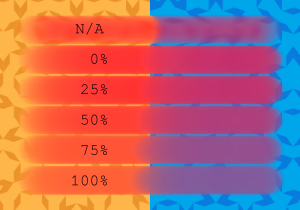
%50 renk oranı, %50 bulanıklaştırma uzunluğu ve %50 matlıkla yapılmış çeşitli fırça darbeleri; ancak farklı bulanıklaştırma yarıçapları kullanılmıştır. En üstteki darbe bulaştırma kipi’nde olduğundan, leke yarıçapı bu darbede etkili değildir.¶
5.0 sürümünde değişti: 5.0 sürümünden önce, Bulanıklaştırma Yarıçapı %3.00.00’a kadar çıkabiliyordu; ancak programın içsel değeri, görüntülenen değerin 1/100’üydü. 5.0 sürümünden itibaren, görüntülenen ve dahili değer birleştirildi ve Leke Yarıçapı en fazla %300 olacak şekilde sınırlandırıldı — tasarlandığı gibi.
Kaplama¶
Kaplama, lekeleme fırçasının tüm katmanlardan mı (kaplama açıkken), yoksa yalnızca geçerli katmandan mı örnek alacağını belirleyen bir anahtardır.
Öntanımlı olarak, Renk Lekesi Fırçası yalnızca bulunduğu katmandan bilgi alır. Ancak, tüm katmanlardan renk bilgisi almasını istiyorsanız, Kaplama kipini etkinleştirebilirsiniz.
Ancak şunu unutmayın: Bu işlem, alt katmandan “parçalar alarak” gerçekleşir; dolayısıyla alt katmanda daha sonra yapacağınız değişiklikler çiziminizi bozabilir.
Boya Kalınlığı¶
Added in version 5.0.
Bu ayar, açıklık kiplerinin geçerli rengi ne kadar etkilediğini belirler. Çünkü Renk Lekesi Fırçası bulanıklaştırma yapar; aslında olan şey, açıklık bileşeninin ayrı bir yükseklik haritasına boyanmasıdır. Bu, geçerli açıklık fırça ucunun gölgelerinin ve parlaklıklarının lekelemeye karışmasını engeller — aksi takdirde tüm lekelemeler beyaz veya siyah olurdu. Bu yükseklik haritası, fırça işletkesi, katman veya araç değiştirildiğinde silinir. Yükseklik haritası yalnızca düzenlenen katmanda var olduğundan, açıklık fırçaları ve boya kalınlığı Kaplama ile birlikte kullanılamaz.
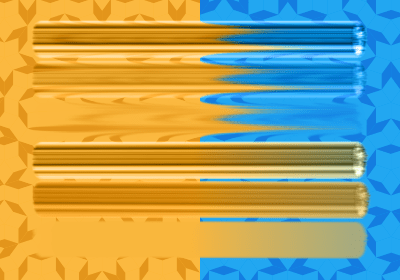
Boya Kalınlığı’nın farklı varyasyonlarını gösteren görsel; üstteki üç darbe Bulaştırma Kipi’nde, alttaki üç darbe ise Matlaştırma Kipi’nde yapılmıştır. Güç değerleri yukarıdan aşağıya doğru sırasıyla %100, %50 ve %0’dır.¶
Bu ayarın iki kipi vardır; var olan yükseklik haritasının nasıl yorumlandığını değiştirir:
- Var olan boya kalınlığının üzerine yaz (düşük olduğunda pürüzsüzleştir)
Burada fırça darbesinin açıklık değeri, önceden var olan değerin üzerine yazılır; boya kalınlığı düşükse önceki boya etkili bir şekilde yumuşatılır. Matlık ayarı, önceki boya yüksekliğiyle karışmasına neden olur; ancak bu aynı zamanda rengi de azaltır. Bu kip, hem kalınlıkla boya yapabilen hem de istenirse var olan boyayı yumuşatabilen fırçalar için kullanışlıdır.
- Var olan boya kalınlığının üzerine boya (leke uzunluğu tarafından denetlenir)
Burada açıklık değeri, yukarıda açıklandığı gibi Leke Uzunluğu’na bağlı olarak önceki değerlerle karışır. Bu, Üzerine Yaz kipinde Matlık ayarının sağladığı boya yüksekliğiyle harmanlama türünü olanaklı kılar; ancak renk oranını etkilemeden.
İki kipi gösteren bir görsel: üstteki darbeler Var olan boya kalınlığının üzerine yaz kipinde, alttaki darbeler ise Var olan boya kalınlığı üzerine boya kipindedir. Her iki durumda da %100 boya kalınlığıyla kırmızı bir darbe uygulanmıştır. Üzerine mavi darbeler, ince kalından kalına doğru yerleştirilmiştir. Var olanın üzerine boya türünün, %0 ile %100 Leke Uzunluğu arasında nasıl farklılaştığına dikkat edin.¶
Ton, Doygunluk, Değer¶
Piksel fırça işletkesindeki Hue, Saturation, Value ile özdeş olan bu ayar, geçerli ön plan rengini Renk Oranı aracılığıyla karıştırılmadan önce düzenler. Bu özellik, fırça işletkesinde daha önce gökkuşağı benzeri bulaşmalara yol açan küçük bir yuvarlama hatası nedeniyle eklendi; söz konusu hata düzeltildi. Ancak bu etkiyi seven sanatçılar, artık şu adımları izleyerek benzer bir görünüm elde edebilir: Ton etkinleştirilir, Bulanık Sürüş etkinleştirilir, Basınç devre dışı bırakılır ve son olarak Güç %40’a ayarlanır.

Üst: Ton varyansı olmadan, Alt: Ton varyansıyla.¶
Gradyan Kipi kullanan fırça uçlarında, Ton, Doygunluk ve Değer ayarları etkili değildir.
Fırça Uçları¶
Renk Lekeleme Fırçası, Piksel Fırça İşletkesi ile aynı Fırça Uçları ögesinin tümüne sahiptir!
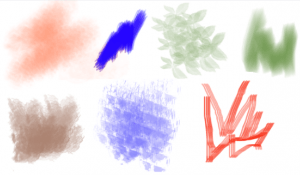
Unutmayın ki leke etkileri, fırça ucunun matlığı düşük olduğunda daha zayıf olur. Bu nedenle düşük matlığa sahip fırça uçlarında, matlığı ve leke/renk oranlarını artırmanız gerekir.
Saçılma ve Diğer Şekil Dinamikleri¶
Renk Lekesi Fırçası, Piksel Fırça İşletkesi ile birçok ortak seçeneği paylaşır.
Ancak leke etkileri nedeniyle sonuç, Piksel Fırçası’ndan farklı olacaktır. Özellikle Saçılma seçeneği çok daha önemli hale gelir.

Dikkat edilmesi gereken birkaç nokta:
Saçılma, fırça boyutuyla orantılıdır. Küçük yuvarlak bir fırça için %500 saçılma kullanmak sorun olmaz; ancak daha büyük fırçalar için bu değeri %50 veya daha altına indirmeniz daha iyi sonuç verir.
Bulaştırma seçeneğiyle birlikte bazı çizgileri fark edebilirsiniz. Bunlar, fırçanın dikdörtgenin sert kenarlarını alıp bulaştırmasından kaynaklanır.
Saçılma sırasında fırça, doğrudan fırçanın altındaki rengi değil, belirli bir uzaklık içindeki renkleri alır.

Öğretici: Renk Lekesi Fırçaları¶
İlk bölüme en azından göz gezdirmenizi öneririm; böylece neyin ne işe yaradığını genel hatlarıyla anlayabilirsiniz.
Lekeleme ve Harmanlama¶
Bu bölüm, Renk Oranı kapalıyken kullanım senaryolarını açıklar.
Dinamik ayarlarının ayrıntılarına girmeyeceğim; açıklamaları Piksel Fırçası öğreticisi bölümünde bulabilirsiniz.
Lekeleme Efektleri¶
Basit lekeleme için:
Renk Lekesi Fırçası’nı seçin. Hem Bulaştırma hem de Matlaştırma kiplerinden birini kullanabilirsiniz.
Renk oranını kapat
Dışa doğru lekele
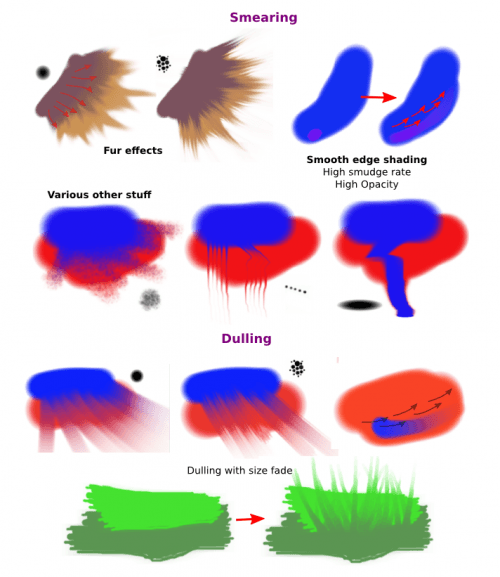
Düşük matlığa sahip fırça uçları kullanırken, daha az görünür etkiyi “telafi etmek” için hem Leke Oranı hem de Matlık değerlerini artırmayı unutmayın — gerekirse en yüksek değere kadar.
Bulaştırma için bazı ayarlar¶
Daha pürüzsüz bir bulaştırma için aralığı azaltın. Unutmayın ki aralık değeri, fırça ucu boyutuyla orantılıdır. Küçük yuvarlak bir fırça için 0,10 aralık uygundur; ancak orta ve büyük boy fırçalar için bu değeri 0,05 veya daha altına indirmeniz önerilir.
Matlaştırma için bazı ayarlar¶
Aralığı düşürmek, lekeleme etkisini de güçlendirir; bu yüzden doğru dengeyi bulmak önemlidir. Çoğu orta boy yuvarlak fırça için 0,10 aralık değeri genellikle yeterlidir.
Bulaştırma’dan farklı olarak Matlaştırma, fırça şekli ve boyutunu korur; bu yüzden Bulaştırma fırçalarında olduğu gibi boyut zamanla “solmaz”. Bu etkiyi basit boyut solması dinamiğiyle taklit edebilirsiniz.
Dokulu Harmanlama¶
Bu durumda burada “Harmanlama” olarak adlandırdığım şey, yalnızca aşağıdaki iki dinamikten birinin kullanılmasıdır:
Döndürme, Uzaklık veya Bulanık olarak ayarlı
- Ve/veya saçılma:
Çoğu orta boy fırça için saçılma oranını %50 veya daha altına indirmeniz büyük olasılıkla daha iyi sonuç verir. Daha yüksek ayarlar, küçük fırçalar için uygundur.
Unutmayın ki Saçılma, doğrudan fırçanın altındaki rengi değil, belirli bir uzaklık içindeki renkleri alır (bkz.:ref:option_brush_tip).
İsteğe Bağlı: Boyut ve diğer dinamikleri artırın, fırça uçlarını çeşitlendirin. Aslında Renk Lekesi Fırçası bir bulanıklaştırma fırçası değildir; bu yüzden bulanıklaştırma, “pürüzsüz” geçişler için çok uygun bir yöntem değildir. Pürüzsüz bir şekilde karıştırmak için daha iyi sonuç alabileceğiniz yöntemler şunlardır:
Geçişi oluşturmak için ara değerlerle boyama yöntemi, ilerleyen bölümlerde açıklanacaktır.
Veya bu öğreticinin sonunda kısaca bahsedeceğim “yumuşatılmış seçimle bulanıklaştırma” yöntemini kullanarak.
Renk Lekesi Fırçası ile pürüzsüz geçişler elde etmeye çalıştım; döndürme ve saçılma dinamikleri ekledim; ancak dürüst olmak gerekirse berbat göründüler.
Ancak Renk Lekesi Fırçası, “dokulu harmanlama konusunda oldukça başarılıdır:

Temel olarak önce boyama yapabilir, ardından dokulu geçişleri ekleyebilirsiniz.
Renklendirme¶
Bu son bölümde Renk Oranı açıktır.
Katman Seçenekleri¶
Başlamadan önce, kurulumunuz için birkaç farklı olasılığa sahip olduğunuzu unutmayın:
Aynı katmanda gölgelendirme
Ayrı bir katmanda gölgelendirme yapmak —özellikle alfa devri kullanıldığında— fırçanın bulunduğu katmanın saydamlığıyla karışmasını sağlar. Bu da şu anlama gelir:
Altındaki alan az çok homojense, sonuç aslında aynı katmanda gölgelendirme yapılmış gibi olur.
Ancak altındaki alan homojen değilse, daha az renk varyasyonu elde edersiniz.
Ayrı bir katmanda, Kaplama kipini kullanarak gölgelendirme yapmak. Bunu yalnızca alt katmanı düzenlemeniz gerekmeyeceğinden oldukça eminseniz kullanın; aksi takdirde renkler karmaşık bir hâl alabilir.

Saydamlıkla ilgili konu¶
Renk Lekesi Fırçası, saydamlıkla harmanlar. Bu da şu anlama gelir: yeni, saydam bir katman oluşturup bu katman üzerinde “boyama” yaptığınızda, neredeyse her zaman tam matlıktan daha düşük bir görünüm elde edersiniz.
Temelde:
Boş bir tuval üzerinde renklendirme yaparken harika görünebilir.
Ancak altına bir şey eklediğinizde o kadar iyi görünmeyebilir.

Ancak çözüm oldukça basittir:
- Öncelikle altındaki alanın renklendirilmiş olduğundan emin olun:
Renklendirme ile, altındaki alan zaten renklendirilmiş olur; yani bu adım tamamlanmış demektir.
Boyama yaparken, arka plan katmanını önce kabaca renklendirin.
Veya şekli yeni bir katmanda renklendirip alfa devrinden yararlanın.
Son çözüm için, en iyi etkiyi elde etmek adına kullandığınız renkle yüksek karşıtlık oluşturan renkleri tercih edin. Örneğin, önce en koyu gölge alanını veya en açık parlak noktaları renklendirin ve ardından karşıt renkle çalışmak için Renk Lekesi Fırçası’nı kullanın.

Yumuşak Gölgelendirme¶
Diyelim ki az çok düzgün renk geçişleri istiyorsunuz. Şunlardan birini yapabilirsiniz:
Renk Oranı, yuvarlak fırçalar için %10 kadar düşük olabilir; tam opak olmayan fırça uçlarında ise daha yüksek ayarlanmalıdır.
Veya Leke Oranı değerini %10 kadar düşük ayarlayın.
Veya ikisinin birleşimini kullanın. En iyi sonucu elde etmek için lütfen kendiniz deneyin.
İsteğe Bağlı: Daha yumuşak harmanlama için Döndürme seçeneğini etkinleştirin.
İsteğe Bağlı: Belirli efektler için Saçılma seçeneğini etkinleştirin.
İsteğe Bağlı: Gerektiğinde Boyut ve Matlık dinamikleriyle oynayın.

Bu, aslında düzgün geçişler elde etmek için pek de ideal bir yöntem değildir. Bunun yerine, ara değerleri kademeli olarak oluşturmak en iyisidir. İşte şöyle:
Önce mavi alanın üzerinden kırmızı renkle üç kez geçtim. Üç farklı ton seçiyorum.
Bu değerlerin her birini Kontrol +
 kısayoluyla renk seçerek aldım, ardından sırayla kullandım.
kısayoluyla renk seçerek aldım, ardından sırayla kullandım.
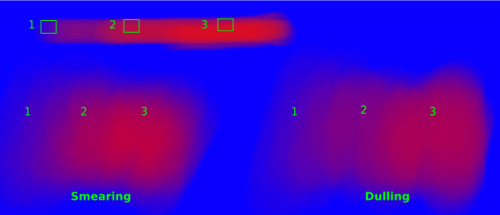
Boyama: Kalın Yağlı Boya Stili¶
İçerilen renk lekesi fırçası önayarlarının çoğu, kalın yağlı boya benzeri bir etki üretir. Bu etki, esas olarak bulaştırma kipinin etkinleştirilmesiyle elde edilir. Temelde:
- Bulaştırma kipinde, yüksek leke ve renk oranlarıyla.
Her ikisi de 0,50 olarak ayarlandığında, normal yuvarlak fırçalar veya tamamen mat önceden tanımlı fırçalar için uygundur.
Her biri, daha az yoğunluğa sahip fırçalar veya tam mat olmayan önceden tanımlı fırçalar için 1,00 değerine kadar ayarlanabilir.
Gerektiğinde Boyut/Döndürme/Saçılma dinamiklerini ekleyin. Bunu yaptığınızda, artan renk karışımını dengelemek için leke ve renk oranlarını yükseltin.
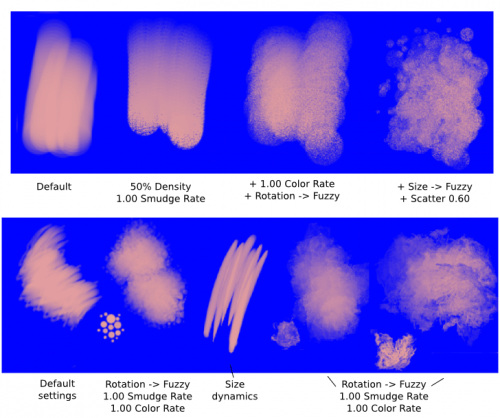
Benim gerçekten hoşuma giden şeylerden biri, farklı ön plan ve arka plan renkleri ayarlayıp ardından seçeneğini etkinleştirmek. Alternatif olarak, sadece farklı renklerle art arda boyama da yapabilirsiniz (sağ alt köşedeki örnekte olduğu gibi).
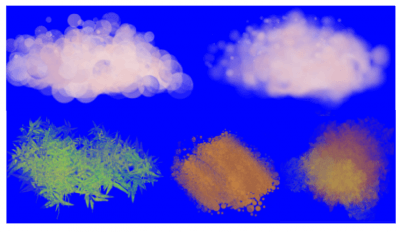
Son olarak birkaç rastgele bilgi: Piksel fırçalarıyla, uzunlamasına fırçalar kullanıp dinamikleri döndürmeye ayarlayarak her türlü süslü deseni elde edebilirsiniz. Renk Lekesi Fırçaları ile bunu yapamazsınız. Bunun yerine… iplik gibi görünen bir şey elde edersiniz. Bu da gayet havalıdır. Burada yalnızca oval fırçalar ve kullandım.
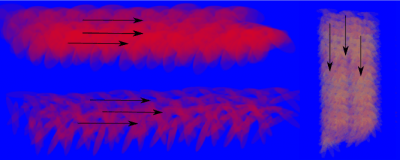
Boyama: Sayısal Suluboya Stili¶
“Sayısal suluboya” dediğimde, çevrimiçi ortamda sıkça görülen bir stile atıfta bulunuyorum; yani gerçekçi suluboyadan ziyade yumuşak ve düzgün gölgelendirme tarzı. Bunun için çoğunlukla Matlaştırma kipi gerekir. Birkaç nokta:
Lekeleme kipinin aksine, daha yumuşak bir etki elde etmek için normal yuvarlak fırçalarda matlığı düşürmek isteyebilirsiniz — örneğin %70’e kadar.
Fırça ucu solma değerini de değiştirin.
Saçılma veya diğer dinamikleri kullanırken, farklı sonuçlar elde etmek için lekeleme ve renk değerlerini yüksek ya da düşük olarak ayarlamayı tercih edebilirsiniz.
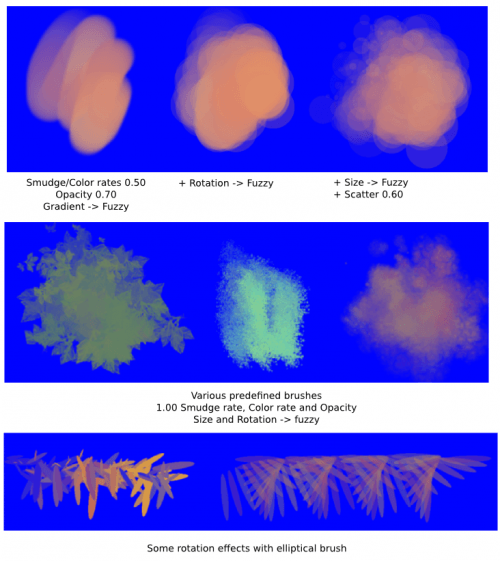
Bulanıklaştırma¶
Şunları yapabilirsiniz:
Önce boyayın, ardından lekeleyin — bu yöntem çoğunlukla doku geçişleri için kullanılır.
Veya geçişleri, ara renk değerlerini kullanarak kademeli biçimde oluşturun.
Daha da yumuşak efektler istiyorsanız bulanıklaştırma kullanın. Tam olarak söylemek gerekirse Gauss bulanıklaştırmasını.
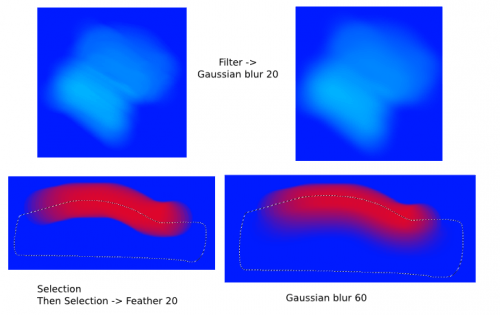
İşte böyle. Bu son küçük ipucu ile bu öğretici tamamlanmış oluyor.
